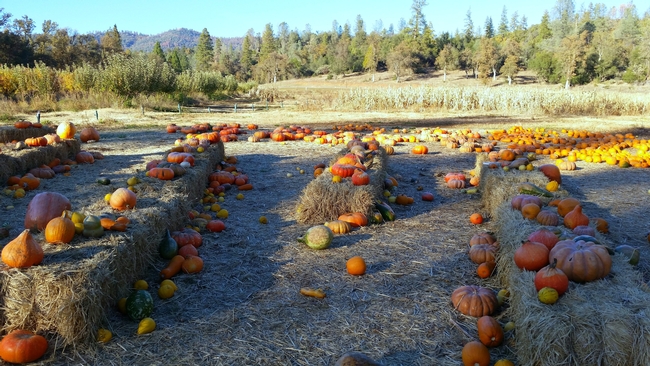
Posts Tagged: pumpkin
Hey There, Pumpkin! Prey Tell, Is That a Praying Mantis?
Hey there, pumpkin! Prey tell, is that a praying mantis stalking a bee? Well, if your name is Allan Jones of Davis, Calif., and you capture images of insects throughout the year--especially at the 100-acre UC Davis Arboretum and Public Garden and the half-acre Häagen-Dazs...

A praying mantis "shopping for bees" on a sunflower, became the subject of one of Allan Jones' carved pumpkins. (Photo by Allan Jones)

The mantis-and-bee image that Allan Jones captured became a fanciful pumpkin. (Photo by Allan Jones)

Images of a luna moth, Actias luna, found a home on one of Allan Jones' pumpkins. (Photo by Allan Jones)
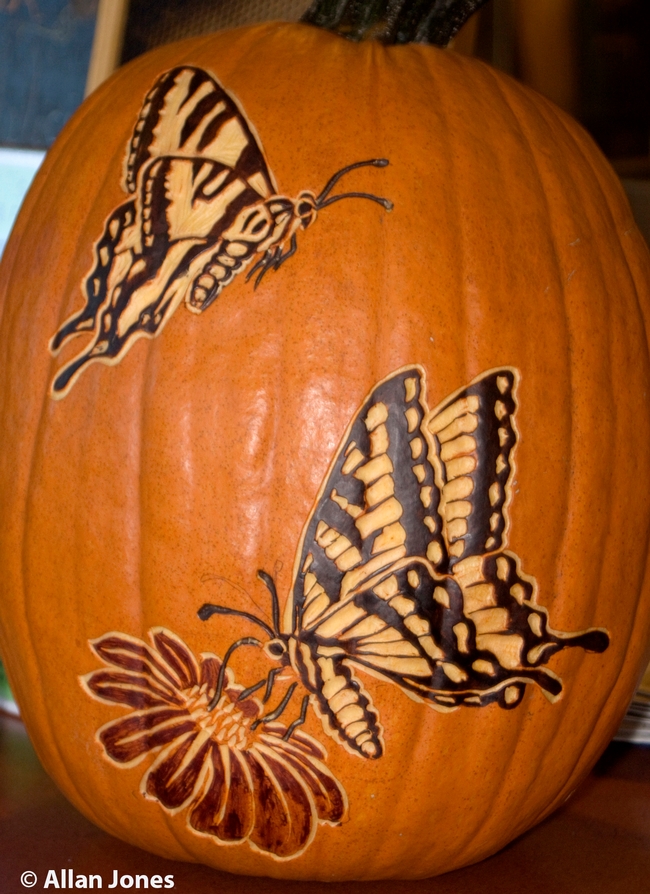
Allan Jones depicted the colorful Western tiger swallowtails, Papilio rutulus, on this pumpkin. (Photo by Allan Jones)
Thank the Squash Bee on Thanksgiving
If you're having pumpkin pie or butternut squash this Thanksgiving, thank the squash bee. Squash bees are specialists (not generalists) that pollinate only the cucurbits or squash family, Cucurbitaceae, which includes pumpkins, squash, gourds, cucumbers and zucchini. Last summer...

A squash bee, Peponapis pruinosa, pollinating a squash blossom. (Photo by Kathy Keatley Garvey)
Close-up of a squash bee,Peponapis pruinosa. (Photo by Kathy Keatley Garvey)
Happy National Squash Bee Day!
In case you missed it, today was National Pumpkin Day. But it ought to be National Squash Bee Day, because the squash bee (my favorite species is Peponapis pruinosa) is an important pollinator of squash and pumpkins. A little bit about the squash bees: Squash bees are specialists; not...
Squash bee, Peponapis pruinosa, inside a squash blossom. (Photo by Kathy Keatley Garvey)
The well-rounded pumpkin: A versatile vegetable
In addition to those grown for use as jack-o-lanterns, varieties such as Sugar Pie and Fairytale work well in the kitchen.
The seeds
Seeds become crunchy snacks when dried and roasted. For both techniques, thoroughly remove the stringy bits of flesh that cling to the outer layer of the seed. Dry at 115°-120°F for 1 to 2 hours in a home dehydrator or in a warm oven for 3 to 4 hours; alternatively, seeds can be dried in the sun. Rotate seeds regularly to promote even drying and avoid scorching. Dried seeds can then be roasted in a 250°F oven with a light spritz of oil and salt for 10 to 15 minutes.
The flesh
Wash the exterior of the pumpkin and remove the seeds and accompanying fibrous strands. The flesh can be skinned and cubed into 1-inch pieces as a starting point. Some home preservation options include:
- Pressure canning – in CUBES only. Do not mash or puree. Put that food processor away; keep botulism at bay.
Note that contents can be mashed when removing the jar from the pantry for use in such foods as pumpkin butter, ice cream, and pie all year round.
- Drying –
- in 1/8-inch thick pieces for a chewy snack.
- make a leather: cook and puree flesh with honey, cinnamon, nutmeg and cloves. This is an appropriate and safe use of that food processor.
- Freeze – cook, mash, cool and freeze for future use.
Want to learn more about the details of these processes? Take a UC Master Food Preserver class or ask a UC Master Food Preserver volunteer. Many programs are accepting applicants for upcoming trainings. The UC Master Food Preserver Program is open to individuals looking to increase community knowledge in home food preservation methods. Applicants for the UC Master Food Preserver Program must be willing to share knowledge and skills learned from the certification training through local community outreach. Prior food preservation knowledge is not a requirement; willingness to teach others is.
Come full circle by saving seeds for next year's garden. Keep seeds and preserved pumpkin products in a cool, dry place until ready to use. Plant seeds in June for an October harvest and go easy on the water – pumpkins make the list of water wise vegetables, according to the UC Master Gardener Program of Marin County. The Pumpkin Production in California publication notes, “Excessive irrigation aggravates root and stem rot problems and increases humidity in the lower canopy, which contributes to foliage and fruit disease.”
If time cannot be carved out for pumpkin preserving this year, the UC Davis Arboretum offers a Carve ‘n Compost workshop later this month. With all these options, be sure to enjoy this October's harvest in one of its many forms.
This story en español.
Pumpkin - It's great for pie and pi!

At Snowden Elementary in Farmersville, Mrs. Joy Smith fully utilizes this amazing squash. She incorporates the pumpkin and its many seeds to teach students about math. These skills are reinforced using tactile and spatial relations. Two excellent educators partner to demonstrate how the seeds can be added, multiplied and placed in arrays. Nutrition educator Grilda Gomez partners with Mrs. Smith to provide nutritional data related to eating the “meat” of the pumpkin as well as its seeds. For Smith and Gomez, pumpkins are not just great for pie but also for pi. Upon completion of math activities, the students continue celebrating the wonders of pumpkins by carving jack-o-lanterns with their high school buddies. While many of the students have eaten pumpkin pie, few have ventured beyond sugary variations of the fruit. On this day the students also get to enjoy a tasty treat prepared by Gomez, pumpkin spread served on whole wheat toast slices.
“Tastes like my ‘buela’s empanadas,” remarks a student.
Yes, similar to the mixture in empanadas, this recipe allows the students to enjoy the full flavor of pumpkin with very little added sugar. Pumpkins provide a terrific supply of Vitamins A and C. They are not just for dessert either. Pumpkins are a wonderful addition to creamy vegetable soups. Winter is approaching, but it’s not too late to pick this versatile squash.
Pumpkin spread
- 16 oz. can pumpkin
- 1/2 cup sugar
- 2 teaspoons pumpkin pie spice
- 1-2 tablespoons lemon juice
Mix in an pan and heat on the stove until it bubbles. Let cool slightly. Ready to eat warm or cold. Store in refrigerator up to 4 days. Use on toast or bread, tortillas, waffles and pancakes.

UC nutrition educator Grilda Gomez, back row far right, poses with the students and their jack-o-lanterns.

